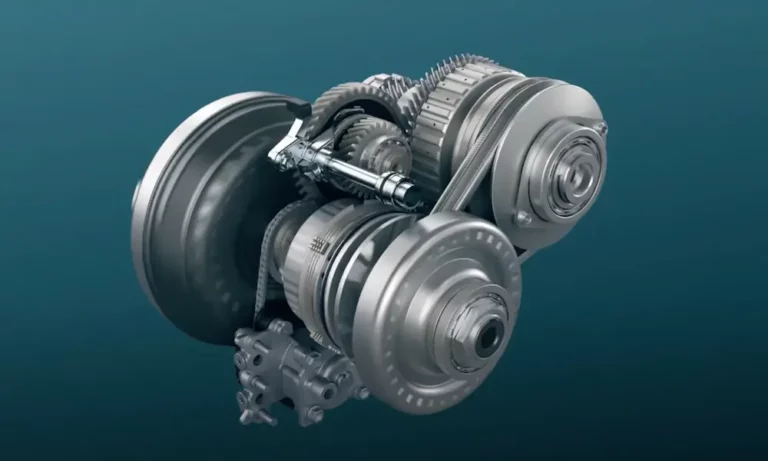Ever found yourself puzzled when car salespeople start throwing transmission acronyms at you? You’re looking at new vehicles and suddenly they’re talking about eCVT, CVT, and you’re wondering if they’re speaking another language. These similar-sounding transmission types actually work completely differently and could significantly impact your driving experience and long-term costs.
I’ll break down exactly how these two technologies differ, which cars use them, and why it matters for your next vehicle purchase. By the end, you’ll know whether a traditional CVT or an eCVT is better for your specific needs.
How eCVTs and CVTs Fundamentally Differ
What is a Traditional CVT?
A traditional CVT (Continuously Variable Transmission) uses a surprisingly simple mechanical approach. Instead of fixed gears, it employs two cone-shaped pulleys connected by a specialized belt or chain. These pulleys can change their effective diameter by moving their sides closer together or further apart.
When you accelerate, one pulley gets smaller while the other gets larger, causing the belt to ride at different points along the pulleys. This creates an infinite number of “gear ratios” without actual gears clicking into place.
The beauty of this system is that your engine can always operate at its most efficient RPM for any given speed. It’s like having hundreds of gears instead of just 5 or 6.
How an eCVT Works (Hint: It’s Completely Different)
Despite the similar name, an eCVT (electronic Continuously Variable Transmission) works on entirely different principles. There’s no belt or pulley system at all!
An eCVT uses a planetary gear set combined with electric motor-generators and sophisticated electronic controls. The Toyota Prius exemplifies this design with its Power Split Device, where:
- One motor-generator connects to the internal combustion engine
- Another motor-generator connects to the wheels
- The planetary gear set creates the relationship between them
The system varies your effective gear ratio by controlling the speed relationship between the electric motors and the gas engine electronically rather than mechanically.
| Feature | Traditional CVT | eCVT |
|---|---|---|
| Core mechanism | Belt/chain with pulleys | Planetary gears with electric motors |
| Found in | Conventional gas vehicles | Hybrid vehicles |
| Primary purpose | Fuel efficiency in gas cars | Power distribution in hybrids |
| Typical maintenance interval | 30,000-60,000 miles | 60,000-150,000 miles |
| Common manufacturers | Nissan, Honda, Subaru | Toyota, Ford, Honda hybrids |
How They Feel on the Road: Performance Differences
The CVT Driving Experience
If you’ve driven a CVT-equipped car, you might have noticed something unusual about how it accelerates. When you press the gas pedal, the engine RPM jumps up and stays there while the car gradually speeds up. This is often called the “rubber band effect” and feels quite different from traditional transmissions.
This sensation happens because the CVT keeps your engine running at its most efficient or powerful RPM rather than stepping through fixed gears. The downside? Many drivers find the constant engine drone annoying, especially during hard acceleration.
Newer CVTs try to address this by programming in artificial “shift points” to feel more like a conventional automatic, but the underlying operation remains the same.
The eCVT Experience
Driving a car with an eCVT feels remarkably different. Since the system can blend electric motor torque with the gasoline engine, acceleration feels more immediate and responsive. The electric motors provide instant torque, eliminating the lag sometimes associated with traditional CVTs.
At low speeds, many eCVT-equipped vehicles can operate in pure electric mode, giving you virtually silent operation. The seamless blending of electric and gas power creates a premium driving experience that many drivers prefer over traditional CVTs.
The sophisticated electronic control allows the eCVT to optimize power delivery based on your driving conditions and efficiency requirements without the mechanical constraints that limit traditional CVTs.
Reliability and Durability: Which Lasts Longer?
CVT Reliability Concerns
Traditional CVTs have had a rocky reliability history, particularly with certain manufacturers. Nissan’s CVTs have developed a particularly troubled reputation, with some units failing before 100,000 miles. These failures typically involve belt wear, pulley scoring, or overheating issues that can lead to complete transmission replacement.
The primary vulnerability in traditional CVTs is the belt/chain system, which experiences constant stress. Heat buildup accelerates belt degradation, and inadequate fluid maintenance can lead to premature failure.
Not all CVTs are problematic, though. Honda and Subaru have generally produced more reliable units, particularly in models manufactured after 2017.
eCVT Proven Durability
Toyota’s eCVT technology has demonstrated exceptional reliability over more than two decades. The absence of wearing belt components eliminates the primary failure mode that affects traditional CVTs. The planetary gear system is inherently robust, with metal-on-metal contact through precision-machined gears rather than flexible belt interfaces.
Many Toyota Prius owners report trouble-free eCVT operation beyond 200,000 miles. When issues do occur, they typically involve the electric motor components, such as bearing wear in the motor-generators, but these failures are relatively rare.
The difference in reliability is so significant that automotive mechanics often specifically warn consumers about CVT reliability while praising eCVT durability.
Maintenance Requirements: What You’ll Pay to Keep Them Running
CVT Maintenance Demands
Traditional CVTs require more frequent and attentive maintenance compared to eCVTs. The constant friction and heat generated by the belt and pulley system necessitates fluid changes every 30,000 to 60,000 miles.
CVT fluids are specifically formulated for each manufacturer’s system and cannot be substituted with generic transmission fluids. Replacing this fluid typically costs $150-$300 per service.
Beyond fluid changes, the belt system may require replacement after 60,000 to 100,000 miles in some applications—a significant expense that can approach $2,000 or more.
eCVT Maintenance Simplicity
The eCVT maintenance schedule is notably more relaxed, with fluid change intervals extending from 60,000 to 150,000 miles depending on driving conditions. Toyota specifically states that eCVT fluid changes are only necessary under severe driving conditions such as desert operation or frequent towing.
Maintenance procedures for eCVTs are straightforward, involving a simple drain and fill process. The cost is typically lower than traditional CVT service, ranging from $100 to $200 for a fluid change.
The reduced maintenance requirements translate to significant savings over the vehicle’s lifetime, offsetting the higher initial cost of hybrid vehicles equipped with eCVT systems.
Vehicle Applications: Which Cars Use These Transmissions
Where You’ll Find Traditional CVTs
Traditional CVTs appear primarily in conventional gasoline vehicles where manufacturers prioritize fuel efficiency. You’ll find them in:
- Most of Nissan’s lineup including Altima, Sentra, and Rogue
- Honda’s conventional models like the Civic, CR-V, and HR-V
- Subaru’s Outback, Forester, and other models
- Select Toyota models like certain Corolla variants
Manufacturers choose CVTs for these vehicles because they can improve fuel economy by 2-3 MPG compared to conventional automatics while providing smoother acceleration.
Where You’ll Find eCVTs
The eCVT is almost exclusively associated with hybrid powertrains, where it serves as an integral component of the hybrid system. You’ll find them in:
- Toyota’s hybrid lineup: Prius, Camry Hybrid, RAV4 Hybrid, and Highlander Hybrid
- Ford’s hybrid vehicles: Maverick Hybrid, Escape Hybrid
- Honda’s hybrid models: Accord Hybrid, CR-V Hybrid, and Insight
The eCVT enables the sophisticated power management required for hybrid operation, seamlessly blending electric and gasoline power while optimizing efficiency.
Cost Considerations: Initial Price vs. Long-Term Savings
Purchase and Ownership Costs
Vehicles equipped with eCVT systems typically command a premium of $2,000 to $4,000 due to the hybrid powertrain complexity. However, this cost is often offset by:
- Improved fuel efficiency (often 15-20 MPG better than comparable non-hybrids)
- Potential tax incentives for hybrid vehicles
- Lower maintenance costs over time
- Better resale value due to reliability reputation
Traditional CVT vehicles generally carry no transmission-related premium compared to conventional automatic transmissions.
Repair Economics When Things Go Wrong
When major repairs become necessary, both transmission types can be expensive, but the failure patterns differ significantly:
- Traditional CVT failures often involve complete transmission replacement due to belt system damage, with costs ranging from $3,500 to $6,000.
- eCVT repairs more commonly involve individual component replacement, such as motor-generator units, typically costing $1,000 to $3,000.
More importantly, the likelihood of needing major repairs is significantly lower with eCVT systems, particularly those from Toyota, which have established an exceptional reliability track record.
Future Outlook: Where These Technologies Are Heading
The trajectory of transmission technology reflects broader industry trends toward electrification. Traditional CVT technology continues to evolve with improvements in belt materials and control systems, but the fundamental mechanical limitations remain.
eCVT technology, meanwhile, benefits from ongoing advances in electric motor efficiency and battery technology. As hybrid and electric vehicle adoption accelerates, eCVT systems are becoming more sophisticated and cost-effective.
The automotive industry’s shift toward electrification suggests that eCVT technology will gain market share at the expense of traditional CVTs in the coming decades. As battery costs decline and hybrid systems become more affordable, the advantages of eCVT systems will become increasingly apparent.
Making Your Choice: Which Transmission Is Right for You?
If you’re primarily concerned with initial purchase price and don’t mind more frequent maintenance, a traditional CVT in a reliable model (preferably Honda or Subaru rather than Nissan) can provide good fuel economy and smooth operation.
However, if you prioritize:
- Long-term reliability
- Minimal maintenance requirements
- Refined driving experience
- Maximum fuel efficiency
An eCVT in a hybrid vehicle offers compelling advantages despite the higher upfront cost. The Toyota hybrid system with its eCVT has proven particularly bulletproof, with many vehicles exceeding 200,000 miles without transmission issues.
Your driving patterns also matter. If you do mostly city driving with frequent stops and starts, a hybrid with an eCVT will deliver the greatest benefits in both driving experience and fuel economy. For highway commuters, the advantages are less pronounced but still significant over the vehicle’s lifetime.
Ultimately, the eCVT represents more advanced technology with better long-term value, while traditional CVTs offer a more affordable entry point into continuously variable transmission technology—just be sure to research the reliability history of your specific model before buying.



